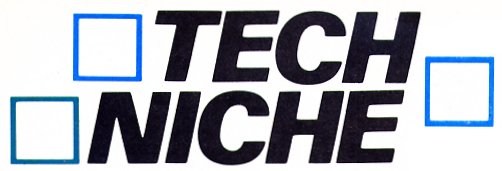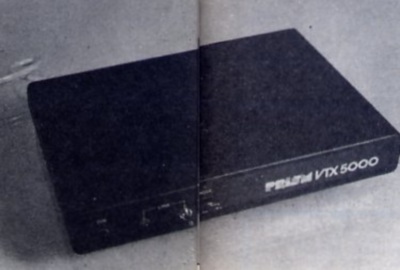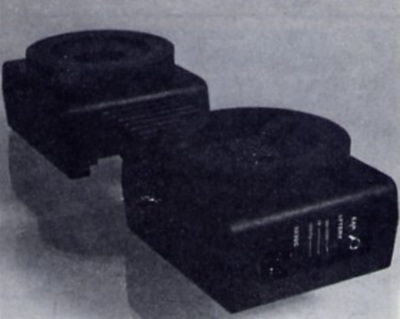

In the last issue of Tech Niche we promised you a review of Spectrum modems. On the face of it that was a little bold, not only because there are so many modems about but also because the manufacturers of them are either a) mean b) hard to find c) don’t want to be found or d) they never really had a modem in the first place.
Anyway enough excuses. We did manage to decide on the two most important modems to review in this issue and we’ll pass over the other for the meantime.
The VTX 5000 and the Protek 1200 modems are both front runners simply because they provide an uncomplicated means of communicating with Prestel or, perhaps more importantly Micronet, at a reasonable cost. These two modems are limited because they do not provide the facilities that would allow you to communicate easily with every sort of on line computer there is — there are modems that do, but generally they cost a lot more and are more complicated to set up. When we reach the stage of examining hobbyist bulletin boards and specialist databases we shall also examine some of the kit that is needed to make those connections. But they will have to wait for a future Niche.
To begin to explain why modem compatibility is nearly as big a laugh as computer software compatibility, it is necessary to take a look at the workings of modems. As stated in the last issue Modem is simply a shortened form of MOdulator DEModulator. We all know that computers hump information around internally as representations of one’s and zero’s. Computers really aren’t that smart: to a computer life is very simple, a situation is either black or white, on or off, one or zero. All this means is that if a computer wants to tell somebody that it knows The Answer it can’t simply shout out ‘forty two’, well it can, but only because the computer knows how to turn its version of ‘forty two’, 101010, into our version of ‘forty two’ — 42.
So if one computer wants to chat to another computer it will do so in a signal representing binary numbers, and all that the modem does is to take the binary message and turn it into a form that can be sent down a standard telephone line. Fed with data in serial rather than parallel form, all a modem does is convert characters into sequences of notes for transmission, and decode incoming signals which have been sent down the telephone line, assemble them into characters and hand them over to its host computer.
In the case of the basic Spectrum, which doesn’t have a RS232 port fitted as standard, you either need to get hold of a modem which connects directly to the edge connector and sorts out the interfacing problem for itself, or use a suitable RS232 interface for your Spectrum which should allow you to connect it to any modem. The RS232 interface provided on Interface 1 isn’t up to the job, although people are rumoured to be working on that problem.
Once you’ve got a modem attached to a Spectrum and working, the next problem is to make sure that it is compatible with the modem at the other end of the line. They must both talk the same language in order to hold a successful conversation. A number of variables are involved, the two most important of which concern the speed with which the signal is sent and the pitch of the notes used.
In Europe we have two main standards. CCITT V.21 which is for 300/300 baud communications, and the V.23 for 1200/75. The baud rate is a measure of the speed at which data is transmitted. Typically, 300 baud represents a rate of about 30 characters a second, while 1200 baud is about the fastest speed of transmission achievable on a normal telephone line, and works out at about three lines of text on the Spectrum screen per second.
The V.21 standard is used by most hobbyist bulletin boards and on-line services. If you want a modem to talk to these chaps then it must be able to adopt that standard (neither the VTX or the Protek can). The most widely used standard now being used by Spectrum owners, due largely to Micronet, is the 1200/75 baud V.23. This is the standard adopted by Prestel which sends frames at 1200 baud and receives instructions at 75 baud. It was this standard that the VTX and Protek modems were designed to use. Some bulletin boards cater for 1200/75 communications, however, and user-to-user communication is also possible with these modems.
If you have a burning desire to go truly international and communicate with systems in the USA or Canada, then you will have to consider yet another range of standards. The American Bell 103 is similar to our V.21 and the Bell 202 is like our Prestel (V.23) standard except that Bell uses different pitches to CCITT systems. Modems are around that can switch between all these different standards — but at a price. We hope to bring you news of one of these, the new Miracle Modems Spectrum version soon. There’s no point on lashing out on super whizzo (and expensive) hardware if your main interest is in talking to Prestel and Micronet, however.
Apart from the communications software needed to drive the modem itself and sort out such housekeeping problems as word length and parity so that the receiving modem on a system is sent what it expects to receive, a further problem can arise from lack of compatibility with software. Clearly the computer that you want to talk to and your computer both need software to organise a multitude of functions be it simply transmitting chunks of text to another computer or sending a message to a mailbox on a large system.
The problem is that each computer has a different view of the outside world. For example, problems may be caused by incompatible character sets. Prestel would never understand what a Spectrum SYMBOL SHIFT keypress was meant to mean, but software converts it to be sent as a star — that’s fine because the Prestel machine knows that the star means an instruction is on it’s way. Saves a lot of argument and down time with grumpy computers does the software.
Remember that no matter how smart a modem is, without the software it’s just a pile of chips and capacitors. The software that comes with the VTX and the Protek modems is able to convert the Spectrum’s output into a form understood by Prestel, and a few more clever tasks besides.

The Prism VTX 5000
Supplier: Modem House
Price: £49.95
This modem really seems to have become the standard for clever people (a recent survey shows that most clever people own Spectrums Source: SEOS 1985). The principal advantages with the VTX are two fold. Firstly the software is held on ROM (read only memory) which means the machine is raring to go on power up so time is saved especially when, as often happens, your connection with the mainframe is broken and you have to re-set the Speccy. The second advantage is that the modem is hard wired, plugging into the phone socket and then the phone plugs into the back of the modem. This greatly reduces the chances of the modem being interfered with by outside noises! The software has most of the functions that you could need including automatic log on and off. Micronet frames can be saved to tape or microdrive and printed out, you are able to download the software or compile messages off line loaded to tape ready to be sent when you are on line. The VTX can be used as a user to user modem to allow you to communicate with other users so long as the same V.23 standard is observed. Other software is available for the machine which allows you contact databases and bulletin boards that use the same speeds but transmit text in a rolling form as opposed to screen by screen. Specnet by Stephen Adams costs £5.95 and a similar package by Stephen Gold can be downloaded from Micronet for a small charge.

The Protek 1200
Supplier: Protek and high street shops
Price: £39.95
The battery powered Protek machine is £10 cheaper than the VTX, but it presents the disadvantages of having to load the software into your machine before you can go on line. Also, the modem is acoustically coupled, which can give you some very undignified moments as you try to squidge your handset into the two rubber cups. If you have a trimfone or a phone in a style other than the traditional one then forget it, but being battery powered the modem has certain portability advantages (only really advantageous when you get your Spectrum running off batteries too, though!) While the software is as useful as that of the VTX it is not as easy to use since some functions require you to load in the odd chunk. If you want to use the modem user to user you have to agree which one of you is to be the original sender and who is to receive and then load in the appropriate code. With the VTX modem you only have to slide a switch.
Conclusion
In my opinion the extra £10 for the VTX modem is more than
justified. It is easier to use and simple to set up, it is moderately
idiot proof as well as being neat and tidy when in operation. The only
advantage that the Protek may have is that the acoustic coupler could,
in theory, be used with any computer that can supply it with RS232 input
providing you can write, buy or scrounge the appropriate software to
drive it.